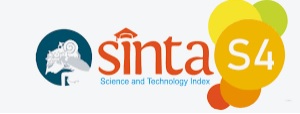Kajian Enterprise Resource Planning pada Industri Manufaktur Pengolahan Bambu menggunakan Arsitektur Enterprise
Abstract
Companies do not just build information technology carelessly and buy information technology equipment without considering aspects of company needs. In planning information technology and systems, it is necessary to conduct a survey and analysis of user needs. So that the results of the survey and analysis become a guide in planning user needs so that the development of technology and information systems can support the company's operations, making it more efficient in running the company. The core of the problem of implementing Enterprise Architecture is to build corporate IT by implementing an Enterprise Architecture based on TOGAF ADM. The purpose of this research is to implement Enterprise Architecture aimed at making IT Planning on the Enterprise Resource Planning application system, in order to be more effective in implementing the application. The roadmap becomes clearer with the Enterprise Architecture. After doing Enterprise Architecture there is a Migration Planning stage, which is used for application to the Enterprise Resource Planning (ERP) application system. The implementation of the ERP system implementation will be carried out in stages using a timeline.
Keywords: Enterprise Resource Planning; Enterprise Architecture; TOGAF-ADM; Bamboo processing manufacturing; Information Technology
Abstrak. Perusahaan tidak hanya membangun teknologi informasi secara sembarangan dan membeli peralatan informasi teknologi tanpa mempertimbangkan aspek kebutuhan perusahaan. Dalam merencanakan teknologi dan sistem informasi perlu dilakukan survey dan analisa tentang kebutuhan user. Sehingga hasil survey dan analisa menjadi panduan dalam merencanakan kebutuhan user sehingga pembangunan teknologi dan sistem informasi dapat mendukung operasional perusahaan, sehingga lebih efisien dalam menjalankan perusahaan. Inti dari masalah penerapan Enterprise Architecture, membangun IT Perusahaan dengan menerapkan Enterprise Architecture berbasis TOGAF ADM. Tujuan penelitian ini adalah melakukan penerapan Enterprise Architecture bertujuan untuk pembuatan IT Planning pada sistem aplikasi Enterprise Resource Planning, supaya menjadi lebih efektif dalam melaksanakan penerapan. Roadmap menjadi lebih jelas dengan adanya Enterprise Architecture. Setelah melakukan Enterprise Architecture ada tahapan Migration Planning, yang digunakan untuk penerapan pada sistem aplikasi Enterprise Resource Planning (ERP). Pelaksanaan dari penerapan sistem ERP akan dilakukan secara bertahap menggunakan timeline.
Kata kunci: Enterprise Resource Planning; Enterprise Architecture; TOGAF ADM; Manufaktur pengolahan bambu; Teknologi Informasi;
References
D. Hindarto, R. E. Indrajit, and E. Dazki, “Sustainability of Implementing Enterprise Architecture in the Solar Power Generation Manufacturing Industry,” Sinkron, vol. 6, no. 1, pp. 13–24, 2021, [Online]. Available: https://jurnal.polgan.ac.id/index.php/ sinkron/article/view/11115.
V. Soraya and W. S. Sari, “Perancangan Enterprise Architecture Sistem Informasi dengan Menggunakan Framework TOGAF ADM pada CV. Garam Cemerlang,” JOINS (Journal Inf. Syst., vol. 4, no. 2, pp. 148–156, 2019, doi: 10.33633/joins.v4i2.3054.
J. F. Andry, “Perancangan Arsitektur Bisnis Pada Industri Aluminium Foil Menggunakan Togaf,” IT J. Res. Dev., vol. 5, no. 1, pp. 98–108, 2020, doi: 10.25299/itjrd. 2020.vol5(1).4755.
Y. Harianto, “Analisa dan Perancangan IT Blueprint Pada Perusahaan Manufaktur (Studi Kasus: PT NLK Indonesia),” JISICOM (Journal Inf. Syst. Informatics Comput ), vol. 3, no. 2, pp. 1–8, 2019.
D. Zaliluddin, “Sistem Informasi Perusahaan Manufaktur (Studi Kasus : CV . Harta Jaya Perusahaan),” Infotech J., vol. 1, no. 1, pp. 21–29, 2012.
Diana, R. E. Indrajit, and E. Dazki, “Penerapan Enterprise Architecture Pada Industri Kosmetik dengan TOGAF ADM.” Jutisi: Jurnal Ilmiah Teknik Informatika dan Sistem Informasi, vol. 11, no. 1, pp. 165-174, 2022.
I. F. Putri, B. M. Izzati, A. Amalia, N. Fajrillah, S. Informasi, and U. Telkom, “Analisis Relevansi Information System Architecture Berdasarkan Kerangka Kerja Kualitas Model Enterprise Architecture,” vol. VII, no. 3, pp. 237–244, 2021.
J. Tutaj, M. Rutkowska, and P. Bartoszczuk, “Enterprise business architecture as a tool for sustainable development in an enterprise - Case study,” Procedia Comput. Sci., vol. 192, pp. 5050–5057, 2021, doi: 10.1016/j.procs.2021.09.283.
O. G. (TOGAF), “Togaf Framework.” https://www.opengroup.org/togaf (accessed May 11, 2022).
S. Umaroh, N. Fitrianti, and M. Iqba, “Perancangan Arsitektur Enterprise Menggunakan Framework Togaf Adm 9.1 Dan COBIT 4.1,” Jurnal Ilmiah Teknologi Infomasi Terapan, vol. 6, no. 2, pp. 122-133, 2018.
A. Supriatna, “Analisa Penerapan Togaf Dan Cobit Dalam Tata Kelola Teknologi Informasi Sebagai Usulan Pada Kementerian Energi Dan Sumber Daya Mineral,” Semin. Nas. Inform., pp. 1–8, 2010.
T. H. Liao, “Online shopping post-payment dissonance: Dissonance reduction strategy using online consumer social experiences,” Int. J. Inf. Manage., vol. 37, no. 6, pp. 520–538, 2017, doi: 10.1016/j.ijinfomgt.2017.03.006.
A. Mazumdar and D. Giri, “On-line Electronic Payment System using signcryption,” Procedia Technol., vol. 6, pp. 930–938, 2012, doi: 10.1016/j.protcy.2012.10.113.
M. Tavana, V. Hajipour, and S. Oveisi, “IoT-based enterprise resource planning: Challenges, open issues, applications, architecture, and future research directions,” Internet of Things, vol. 11, p. 100262, 2020, doi: 10.1016/j.iot.2020.100262.
A. Acha-Anyi, P. N. Acha-Anyi, S. A. Asongu, and V. S. Tchamyou, “Social media for health promotion: A visual analysis of ‘TB proof’ South Africa’s Facebook page,” Technol. Soc., vol. 63, p. 101386, 2020, doi: 10.1016/j.techsoc.2020.101386.
Y. Chawla and G. Chodak, “Social media marketing for businesses: Organic promotions of web-links on Facebook,” J. Bus. Res., vol. 135, pp. 49–65, 2021, doi: 10.1016/j.jbusres.2021.06.020.
D. Hindarto, “Perbandingan Kinerja Akurasi Klasifikasi K-NN, NB dan DT pada APK Android,” JATISI (Jurnal Tek. Inform. dan Sist. Informasi), vol. 9, no. 1, pp. 486–503, 2022, doi: 10.35957/jatisi.v9i1.1542.
D. Hindarto and Handri Santoso, “Android APK Identification using Non Neural Network and Neural Network Classifier,” J. Comput. Sci. Informatics Eng., vol. 5, no. 2, pp. 149–157, 2021, doi: 10.29303/jcosine.v5i2.420.
M. Martins, C. S. E. Silva, J. Magano, and C. S. E. Silva, “Project management maturity in the biotechnology industry,” Procedia Comput. Sci., vol. 196, pp. 748–755, 2021, doi: 10.1016/j.procs.2021.12.072.
X. B. Li, M. Nie, G. H. Yang, and X. Wang, “The Study of Multi-Project Resource Management Method Suitable for Research Institutes from Application Perspective,” Procedia Eng., vol. 174, pp. 155–160, 2017, doi: 10.1016/j.proeng.2017.01.191.
J. F. Jaramillo, D. Ddiba, H. Rueda, K. Andersson, D. C. P, and S. Dickin, “Governance challenges and opportunities for implementing resource recovery from organic waste streams in urban areas of Latin America : insights from Chía , Colombia Authors,” Sustain. Prod. Consum., 2021, doi: 10.1016/j.spc.2021.11.025.
How To Cite This :
Refbacks
- There are currently no refbacks.











